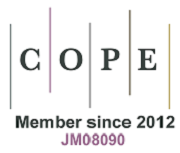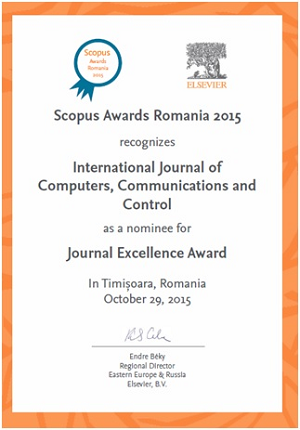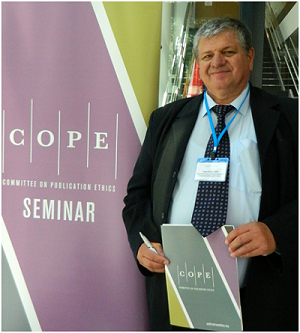A Fairness Load Balancing Algorithm in HWN Using a Multihoming Strategy
Keywords:
Fairness, load balancing, multihoming, quality of service, heterogeneous wireless networks (HWN)Abstract
Due to the growth of the number of intelligent devices and the
broadband requirements, between others technical requirements, of the new
applications, suppose a new challenge in planning, maintenance and resource
allocation in mobile networks for the telecommunication operators. Service
providers must ensure a quality of service for users in a new environment
based in Heterogeneous Wireless Networks (HWN). A good way to achieve
this goal is to prevent the quantity of services of each mobile users being
connected to the same access networks and therefore reducing the possibility
of overloading it. This paper presents a load balancing optimization scheme
that enables operators to make decisions about re-allocation of each of the
services in different access networks, keeping the required Quality of Service
(QoS). In this paper, we propose 1) a mathematical model addressed as a
fairness resource allocation in order to obtain a global load balancing, and 2) a
two-step algorithm based on the anchor-adjustment heuristic to solve it. Our
algorithm contribute to unload the network with maximum load while at the
same time, the other networks are balanced. As a result, we show that our
algorithm finds (near)-optimal solutions while keeps low complexity.
References
Donoso Y., Lozano-Garzon C., Camelo M., Vila P.(2014); A Multihoming Load Balancing Algorithm for a Fairness Resource Allocation in Heterogeneous Wireless Networks, International Conference on Computers, Communications & Control, Romania, Oradea, Baile Felix, May 6-10, 2014, Abstracts of ICCCC 2014, ISSN 1844-4334, 4: 43.
Donoso Y. (2008); Network Design for IP Convergence, Auerbach Pubn, ISBN 978-1420067507.
Global Mobile Suppliers Association, GSM/3G Stats. Fast Facts, Global Mobile Suppliers Association, available at http://www.gsacom.com/news/statistics.php4.
CISCO (2013); Cisco Visual Networking Index: Global Mobile Data Traffic Forecast Update, 2012-2017, Cisco, San Jose, CA, USA.
Kumar S., Anand S.(2011); A novel scalable software platform on android for efficient QoS on android mobile terminals based on multiple radio access technologies, Wireless Telecommunications Symposium (WTS), New York City, 1-6.
Ernst T., Montavont N., Wakikawa R., Ng C., Kuladinithi K. (2008); Motivations and Scenarios for Using Multiple Interfaces and Global Addresses, Draft IETF Monami6 Working Group, 2008.
Lozano-Garzon C., Ortiz-Gonzalez N., Donoso Y.(2013); Mobile Network A Proactive VHD Algorithm in Heterogeneous Wireless Networks for Critical Services, International Journal of Computers Communications & Control, ISSN 1841-9844, 8(3): 425-431.
Tversky A., Kahneman D. (1974); Judgment under Uncertainty: Heuristics and Biases, Science, ISSN 0036-8075, 185: 1124-1131.
Donoso Y., Fabregat R.(2007); Multi-Objective Optimization in Computer Networks Using Metaheuristics, Auerbach Pubn, ISBN 978-0-8493-8084-6.
Sousa B.M., Pentikousis K., Curado M.(2008); Multihoming Management for Future Networks, Mobile Network Application, ISSN 1383-469X, 16(4):505-517.
Capela N., Sargento S. (2012); Optimizing Network Performance with Multihoming and Network Coding, Globecom Workshops, 2012 IEEE, 210-215.
Optimizing Network Performance with Multihoming and Network Coding, Globecom Workshops, 2012 IEEE, 210-215.
Ruiming Y., Yongyu C., Jia S., Dacheng Y. (2012); Traffic Split Scheme Based on Common Radio Resource Management in an Integrated LTE and HSDPA Networks, Vehicular Technology Conference (VTC Fall), 2012 IEEE, 1-5.
Li M., Yu F., Leung, V.C.M., Randhawa T. (2004); A New Method to Support UMTS/WLAN Vertical Handover using SCT, IEEE Wireless Communications, 11(4):44-51.
A New Method to Support UMTS/WLAN Vertical Handover using SCT, IEEE Wireless Communications, 11(4):44-51. http://dx.doi.org/10.1109/MWC.2004.1325890
Liu B., Boukhatem N., Martins P., Bertin, P. (2010); Multihoming At Layer-2 For Inter-RAT Handover, 2010 IEEE 21st International Symposium on Personal Indoor and Mobile Radio Communications (PIMRC), 1173-1178.
Paik E.K., Heo S.Y., Kim H., Jin J.S., Lee S.C., Lee S.H. (2008); Seamless Vertical Handover Using Multihomed Mobile Access Point, 2008 IEEE Global Communications Conference, 1-4.
Seamless Vertical Handover Using Multihomed Mobile Access Point, 2008 IEEE Global Communications Conference, 1-4.
Folstad E.L., Helvik B.E. (2009); Managing availability in wireless inter domain access, International Conference on Ultra Modern Telecommunications & Workshops, 1-6.
Sungwook K., Varshney, P.K. (2002); An Adaptive Bandwidth Reservation Algorithm for QoS Sensitive Multimedia Cellular Networks, 2002 IEEE 56th Vehicular Technology Conference, 3:1475-1479.
Sungwook K., Varshney, P.K. (2003); Adaptive Load Balancing with Preemption for Multimedia Cellular Networks, 2003 IEEE Wireless Communications and Networking (WCNC), 3: 1680-1684.
Adaptive Load Balancing with Preemption for Multimedia Cellular Networks, 2003 IEEE Wireless Communications and Networking (WCNC), 3: 1680-1684.
Shi H., Prasad V., Onur E., Niemegeers I. (2013); Fairness in Wireless Networks:Issues, Measures and Challenges, IEEE Communications Surveys & Tutorials, ISSN 1553-877X, 5-24.
Jain R., Chiu D.M., Hawe W.R., A Quantitative Measure Of Fairness And Discrimination For Resource Allocation In Shared Computer Systems, DEC Research Report TR-301, 1984.
Bayrak A. E., Optimization algorithms for resource allocation problem ff air tasking order preparation, Master Thesis, Middle East Technical University, available at etd.lib.metu.edu.tr/upload/12612325/index.pdf.
Mond. B, Craven B. D. (1975); Non-Linear fractional programming, Bulletin of the Australian Mathematical Society, 12(3) : 391-397.
GAMS Development Corporation, The General Algebraic Modeling System (GAMS), Retrived November 2013, from http://www.gams.com/.
Computational Infrastructure for Operations Research, BONMIN and BONMINH Solvers, available at http://www.gams.com/dd/docs/solvers/coin.pdf.
Teo Y. M., Ayani R. (2001); Comparison of Load Balancing Strategies on Cluster-based Web Servers, Simulation, 77(5-6): 185-195, 2001. http://dx.doi.org/10.1177/003754970107700504
Published
Issue
Section
License
ONLINE OPEN ACCES: Acces to full text of each article and each issue are allowed for free in respect of Attribution-NonCommercial 4.0 International (CC BY-NC 4.0.
You are free to:
-Share: copy and redistribute the material in any medium or format;
-Adapt: remix, transform, and build upon the material.
The licensor cannot revoke these freedoms as long as you follow the license terms.
DISCLAIMER: The author(s) of each article appearing in International Journal of Computers Communications & Control is/are solely responsible for the content thereof; the publication of an article shall not constitute or be deemed to constitute any representation by the Editors or Agora University Press that the data presented therein are original, correct or sufficient to support the conclusions reached or that the experiment design or methodology is adequate.







